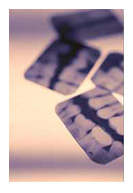
    |

 |
 Q: What part of your body helps you to digest your favorite foods, say "cheese," and look great in pictures? It's true. Your teeth are an important part of your smile, and they also help you chew foods like crunchy apples or yummy pizza. Brushing and flossing are important, but you also need to visit your dentist regularly to keep your teeth strong and healthy. Read this article to learn more about what happens at the dentist's office. What Does the Dentist Do?The dentist is a doctor who is specially trained to care for teeth. When you visit for a checkup, your dentist will look at your teeth and gums to check for any problems. The dentist also wants to make sure your teeth are developing properly as you grow. It's important to visit your dentist every 6 months to make sure you're taking good care of your teeth and that your teeth and gums are healthy. What Happens at the Dentist's Office?After your name is called in the waiting room, you'll go into an exam room and sit down in a big, comfortable chair that is like a huge recliner. The chair will have a place to rest your head and lots of room for you to stretch out your legs. Next to the chair may be a little sink with a cup that you can use to rinse out your mouth as your teeth are being cleaned. During the exam, your teeth will be cleaned, flossed, and checked for cavities. Here's what will happen: Cleaning and FlossingOne of the first people you'll meet at the dentist's office is the dental hygienist (say: hi-jeh-nist). A dental hygienist is a person who knows all about keeping teeth and gums clean and healthy. The dental hygienist will look inside your mouth to make sure your teeth are growing properly and your gums are healthy. A bright, overhead light will shine down into your mouth like a giant flashlight so the dental hygienist can get a good look inside your mouth. The dental hygienist will clean and polish your teeth, using tiny dental tools like a tooth scraper, mirror, and special toothbrush. The tooth scraper removes plaque (say: plak) from your teeth. Plaque is a thin, sticky layer that coats your teeth and contains bacteria (say: bak-teer-ee-uh) that grow on your teeth over time. Plaque that isn't removed from your teeth can cause decay, or a cavity (say: kah-vuh-tee). Next comes brushing and flossing. The dental hygienist will brush your teeth with a special toothbrush and toothpaste. The toothbrush has a small, round tip that moves around and around to clean your teeth. The toothpaste might taste like your own toothpaste at home, but it will feel a little grittier — almost like sand. Then the dental hygienist will floss your teeth and show you the proper way to brush and floss your teeth at home. Flossing involves using a piece of waxy string called dental floss to get in between your teeth and remove food particles that your brush can't reach. Checking for Cavities
During your visit, the dental hygienist will take X-rays, or pictures, of your teeth. X-rays are like superhuman vision. They can show cavities hiding between your teeth and problems beneath your gums. A cavity is a decayed, or rotted, part of a tooth. It does not hurt to get an X-ray and it takes only a few seconds. The dental hygienist will place a thick blanket over your chest (to protect your body from the high-energy waves) and put a piece of plastic (that holds the X-ray film) into your mouth. As you gently bite down on the plastic, you'll have to be very still for a few seconds while the dental hygienist snaps the picture. Fluoride TreatmentsNext it's time for your fluoride (say: floor-ide) treatment. Fluoride is a natural mineral that makes your teeth strong and helps prevent cavities. At the dentist's office, a fluoride gel or foam will be applied to your teeth. Most dental offices offer fluoride treatments with flavoring, like bubble gum or grape. The fluoride treatment will take about 1 to 4 minutes. The dental hygienist will probably tell you not to eat or drink anything (including water) for 30 minutes after the fluoride treatment. Meeting the DentistThe dentist will look at all of your teeth and check your gums to make sure they're strong and healthy. The dentist will also check the way your top and bottom teeth work together. This is called your bite. If he or she thinks you have a problem with your bite, you may be referred to an orthodontist (say: or-tho-don-tist). This is a doctor who specializes in correcting the shape or positions of all your teeth through orthodontia, or braces. The dentist will study your X-rays (looking for cavities or other problems) and ask if you have any questions about your teeth. Your dentist may also prescribe fluoride drops or tablets for you to take every day at home. Presents From the Dentist!When your checkup is over, the dentist usually will have a present for you! The gift is often a free toothbrush or dental floss to use at home or some sugar-free gum. What Happens If I Have a Cavity?If you have a cavity, you'll probably have to come back to the dentist's office for another visit. At that time, the dentist will remove the decayed part from your tooth with special dental tools. Then the decayed area will be filled with materials that will keep your tooth strong and healthy, like tooth-colored or silver fillings. As soon as you sit down in the dental chair, the dentist will give you a tiny shot of an anesthetic (say: ah-nus-theh-tik), a medicine that numbs the area around the tooth. Your mouth may be numb for a little while after you leave the dentist's office, but the anesthestic will soon wear off and you'll be left with a beautiful smile! Dental WordsSome words used at the dentist's office might be new to you. Here are a few and what they mean:
Reviewed by: Lisa A. Goss, RDH, BS, and Garrett B. Lyons Sr., DDS
|

 |
 |
 |



